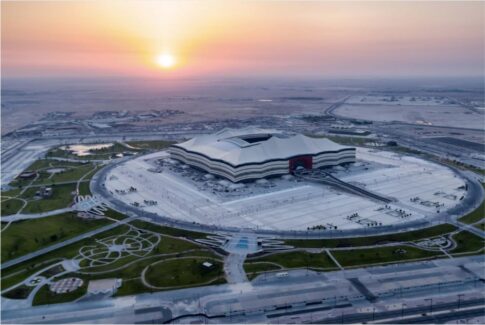
Soccer fans across the globe recently witnessed the start of the FIFA World Cup Qatar 2022 inside the Al Bayt stadium, built by Webuild, approximately 40 kilometers from Doha.
With a capacity of more than 60,000 spectators, the Al Bayt has distinguished itself as a model of sustainability and respect for Qatar’s cultural heritage. Commissioned by the Aspire Zone Foundation, the stadium’s unique and unmistakable shape is inspired by the bayt al sha’ar, the traditional tent of the Qatari that represents hospitality in Arab culture.
The Al Bayt stadium, which hosted the tournament’s opening ceremony with the participation of His Highness Sheikh Tamim bin Hamad Al Thani, and the subsequent match between Qatar and Ecuador, covers more than 200,000 square meters. It is surrounded by parks and other green areas that heighten the city’s livability and offer families a place to enjoy their free time in an open-air setting.
In addition to safety, its key features include the use of advanced materials with a low impact on the environment, some 20% of which derive from renewable sources. The retractable roof reduces energy consumption and allows the sunlight to favor the growth of grass on the pitch. These features led to the stadium receiving two prestigious certifications (Design and Build and Construction Management) in 2020 from the Global Sustainability Assessment System, as it exceeded the requirements set by the client and FIFA. It was identified as best practice in sustainability and reduced environmental impact.
The stadium is also characterized by the innovation deployed during its construction, including complex technical solutions and innovative design features aimed at providing the ideal temperature for players and spectators in a country known for its high temperatures and drastic changes in temperature. The stadium’s external surfaces are in a light color to reduce heat absorption, contributing to the efficient use of air conditioning. The stadium was built to accommodate the needs of the country to receive the public. After the World Cup, the third ring will be removed and donated to developing countries for their own sport infrastructure.





 Join our thriving community of 70,000+ superintendents and trade professionals on LinkedIn!
Join our thriving community of 70,000+ superintendents and trade professionals on LinkedIn! Search our job board for your next opportunity, or post an opening within your company.
Search our job board for your next opportunity, or post an opening within your company. Subscribe to our monthly
Construction Superintendent eNewsletter and stay current.
Subscribe to our monthly
Construction Superintendent eNewsletter and stay current.